Most marketers still treat WhatsApp as a customer service tool. That's a $10 billion missed opportunity. While 3 billion people open WhatsApp daily, only a fraction of businesses use it for lead generation.
The companies that do report conversion increases of 20–60% over email campaigns and cost-per-lead reductions up to 64%.
This article shows you exactly how to join them. It covers nine battle-tested entry points, shares automation strategies that scale, and reveals conversion tactics. These tactics turn casual chats into qualified sales opportunities.
The Numbers That Prove WhatsApp’s Dominance
WhatsApp shows impressive results compared to other channels:
- A 98% message open rate, far above the average email open rate of around 25%.
- Response rates between 45–60%, ensuring frequent follow-up and qualification opportunities.
- Over 3 billion monthly active users, with 83% opening the app daily and spending about 34 minutes per session.
- In Brazil, 96% of companies use WhatsApp to connect with customers, a trend expanding across Europe, Asia, and North America.
- Businesses employing WhatsApp automation report conversion increases of 20–60% over email campaigns.
- Automated messages handle up to 80% of routine inquiries, helping businesses reduce customer service costs by 30–50%.
What Makes WhatsApp Different From Traditional Lead Generation Channels
WhatsApp streamlines the entire customer journey inside a single chat, unlike channels that scatter steps across lead generation forms and emails.
Some key features include:
- End-to-end journeys within one chat, covering acquisition, qualification, nurturing, and conversion.
- Native interactive options like WhatsApp Flows and message forms collect opt-ins and deliver personalized recommendations. All without redirects.
- Commerce-ready tools such as in-chat payments, appointment booking, and real-time notifications that reduce drop-offs.
- Automation at scale comes through instant greetings, quick replies, and chatbots, powered by low-code builders like Typebot. These tools let teams keep personal engagement strong without the need for complex development.
- Full lifecycle support sends reminders, confirmations, updates, and feedback requests, all within WhatsApp. It preserves context and momentum from the first contact to post-sale.
WhatsApp lead generation works across industries. Ecommerce brands use it for product recommendations and cart recovery. Real estate agents share property listings and schedule viewings. Healthcare providers handle appointment booking and patient reminders.
SaaS companies qualify leads and offer product demos. Professional services like accountants and consultants use it for discovery calls. The common thread is personalized, immediate conversations that remove friction from the buying journey.
| Metric | Web Forms | ||
|---|---|---|---|
| Open Rate | 98% | 20-25% | N/A |
| Response Rate | 45-60% | 2-5% | 15-20% |
| Average Response Time | Under 5 minutes | 24-48 hours | Immediate (but no dialogue) |
| Conversation Capability | Two-way, real-time | One-way, delayed | One-way, static |
| Mobile Optimization | Native app | Varies | Often poor |
| Cost Per Lead | Low (up to 64% reduction) | Medium | Medium-High |
| Drop-off Rate | Low (single platform) | High (requires email check) | High (form abandonment 68%) |
Understanding the WhatsApp Lead Generation Funnel
A strong WhatsApp lead strategy treats the customer journey as a conversation. Instead of static web forms or cold emails, the WhatsApp funnel relies on real-time chat. It guides prospects from strangers to buyers through dynamic, two-way interactions.
These interactions qualify and nurture leads within their context.
The funnel focuses on engaging users in the messaging app they already use. It creates exchanges that collect intent, provide value, and maintain momentum.
Getting Discovered on WhatsApp
Brands create entry points that drive discovery, such as:
- Click-to-WhatsApp ads on social platforms
- QR codes at events, stores, or on receipts
- Chat links shared in social posts or stories
These paths open directly into a familiar chat where a personalized greeting or welcome message encourages opt-in. During seasonal peaks like Black Friday, brands drive social traffic directly to WhatsApp chats. This turns discovery into immediate, personalized dialogue.

More than half of holiday shoppers find brands through Meta technologies like WhatsApp.
Capturing Attention Through Conversations
WhatsApp’s high open and response rates make engaging users fast and reliable. Brands use:
- Automated greetings, away replies, and interactive flows to acknowledge new visitors
- Rich media like images, videos, demos, and catalog carousels to answer questions and showcase products
- Clear conversational design with buttons and guided options to reduce friction
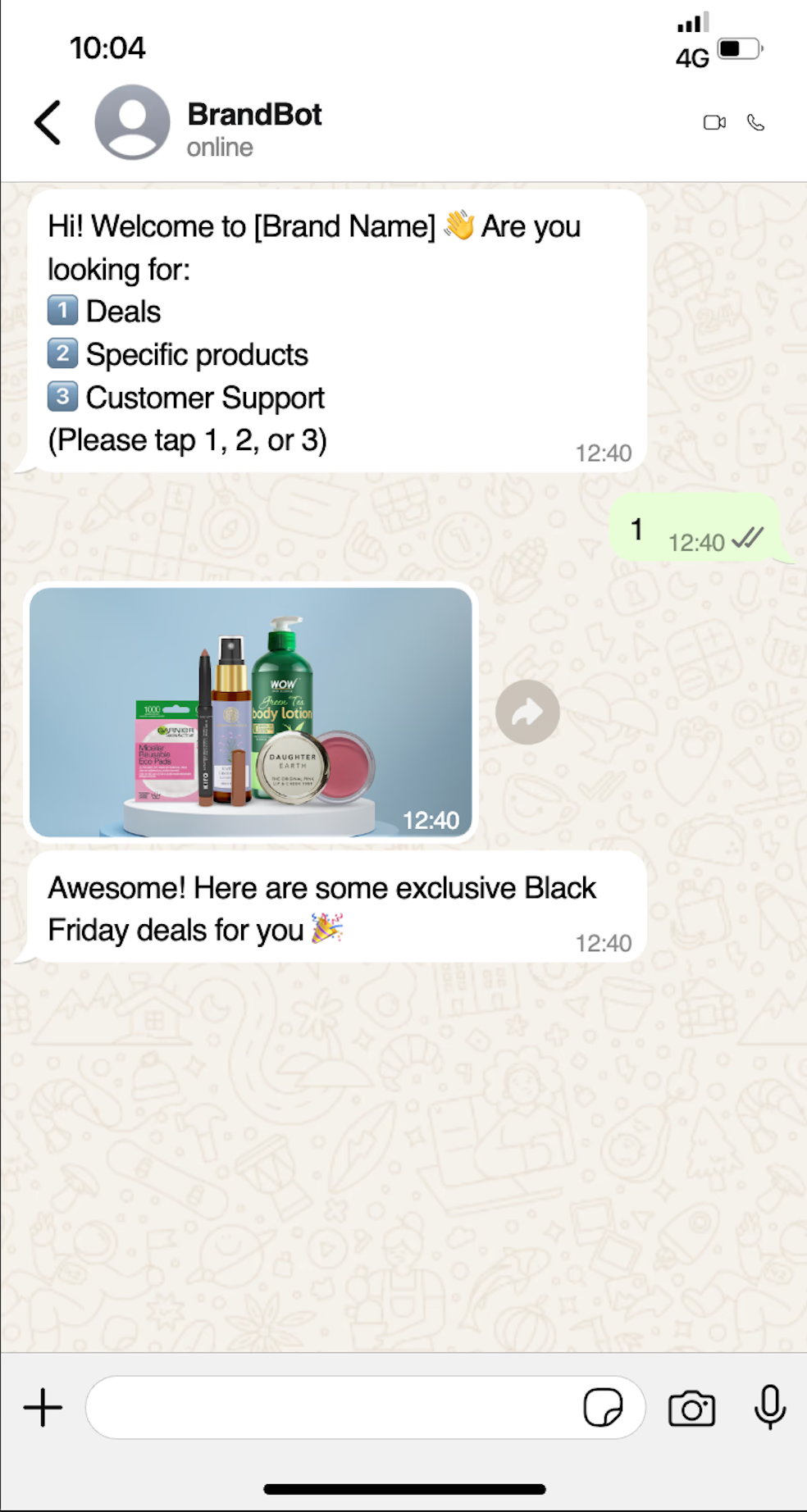
For example, a retail bot might ask, “Looking for deals or specific products?” then direct users based on their choice. This approach turns passive browsing into actionable conversations.
Nurturing Leads With Personalized Messaging
At this stage, personalization and context help qualify leads. Brands:
- Greet users by name and refer to past activity
- Use WhatsApp Flows to gather purchase intent, segment users, and offer targeted incentives like coupons or previews
- Combine automated responses with human handoff for complex questions
Connecting WhatsApp data to a CRM lets businesses use tags and behavior to trigger tailored follow-ups. These include targeted offers, educational content, reminders, and “last chance” messages that keep leads engaged. Personalized messaging builds trust and moves prospects closer to buying.
Turning Conversations into Customers
Brands close sales directly within chat by:
- Sending payment links, showing product catalogs, or offering appointment slots without redirecting users
- Automating secure checkout flows, triggering shipping notifications, and recovering abandoned carts with timely messages
- Using personalized recommendations, discounts, and reminders to encourage decisions
Builders like Typebot provide metrics on completion rates, drop-off points, and engagement. This data helps optimize flows and messaging continuously.
Small teams can begin with simple Typebot flows. Larger organizations can integrate the API and full CRM workflows to scale. This flexibility allows businesses to grow their WhatsApp funnel efficiently.
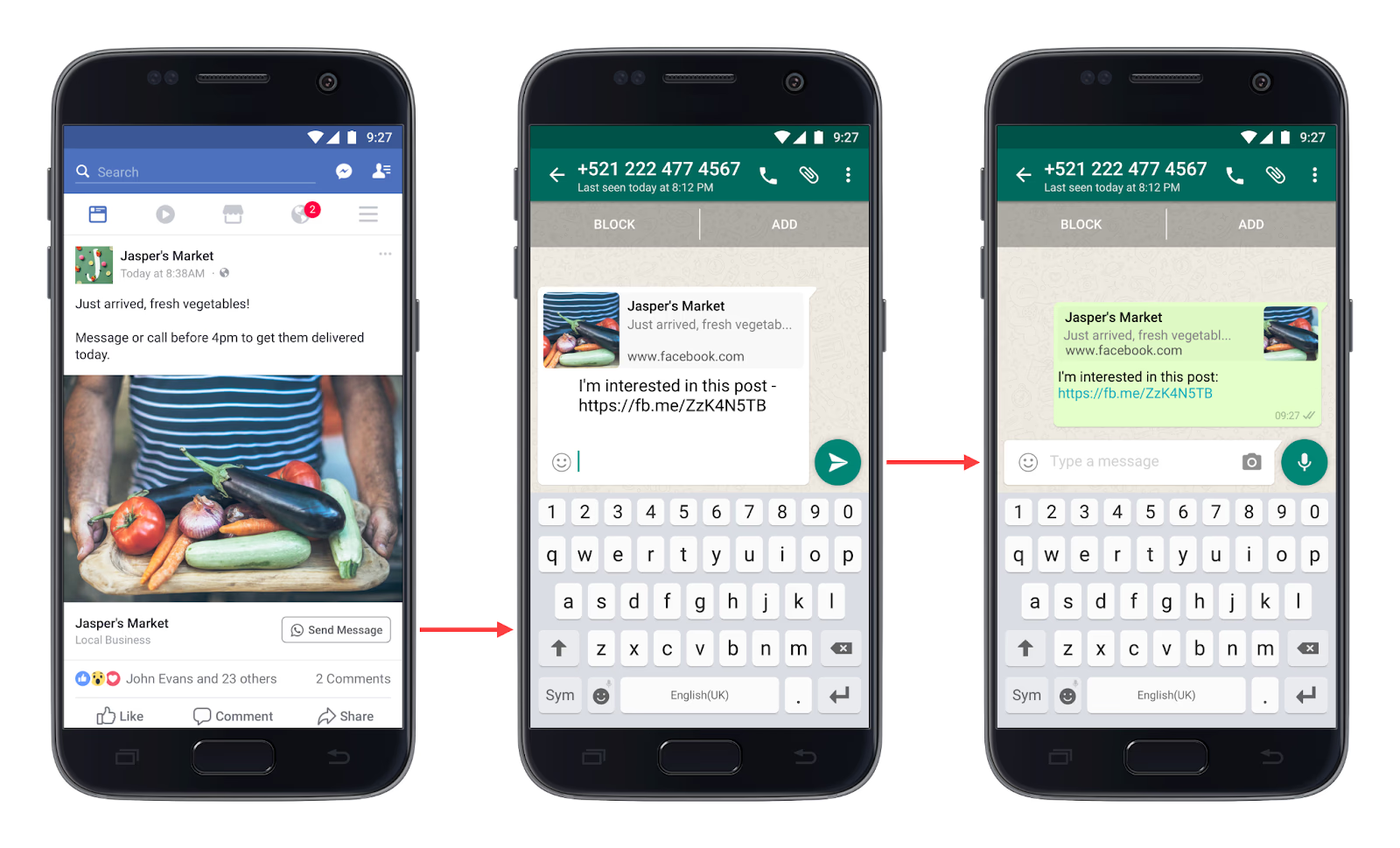
Next, we will explore nine proven entry points businesses are currently using to capture leads directly on WhatsApp.
9 Proven Entry Points to Capture Leads on WhatsApp
Entry points mark the moments when potential customers enter your funnel. Below are nine effective strategies, their reasons for success, and how each relates to the sales funnel stages.
1. Click-to-WhatsApp Ads on Facebook and Instagram
Use dynamic ads that open a WhatsApp chat when tapped. This action changes awareness into an active conversation you can immediately qualify and nurture.
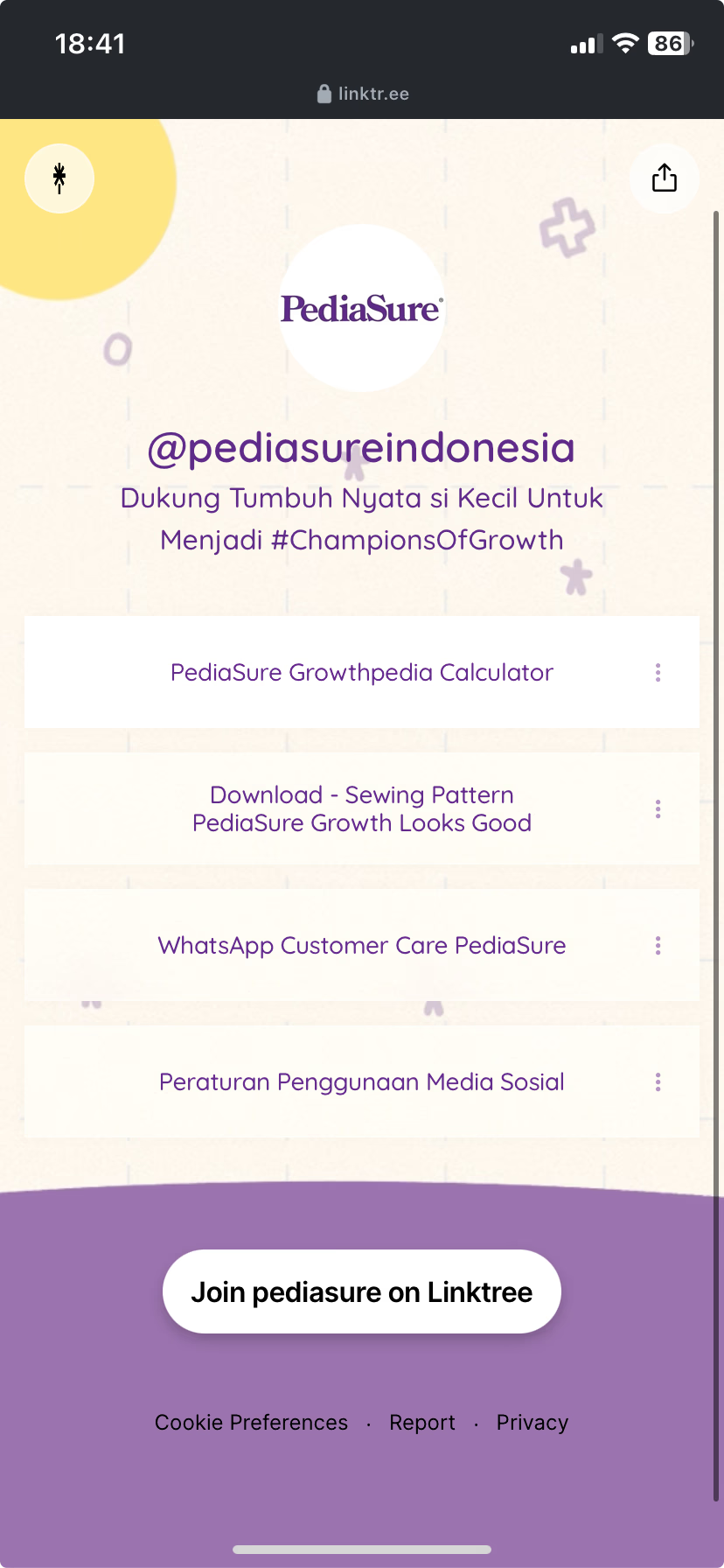

Pediasure Indonesia achieved a 64% reduction in cost per lead using click-to-WhatsApp ads. Their sales funnel involved generating awareness first. Followed by building interest through qualification and data capture within the WhatsApp chat.
2. QR Codes for Offline-to-Online Lead Capture
Place QR codes on displays, packaging, or event materials to guide foot traffic into WhatsApp conversations. This creates a quick transition from physical interest to digital engagement.
The sales funnel begins with offline awareness, where potential customers first learn about the brand. Then, it moves to instant interest and data collection. This the place where engagement is captured and information is gathered directly in conversations.
3. WhatsApp Chat Links and Swipe-Up Stories
Put wa.me links in blogs, emails, or Instagram Stories to shift readers from passive content to two-way messaging. This fits mid-funnel audiences who are already curious about your brand.
The sales funnel moves from interest to consideration by handing users directly to chat. This allows brands to engage prospects in real time, answer
4. Website Chat Widgets That Connect to WhatsApp
Replace static forms with WhatsApp chat widgets so visitors can ask questions, book, or provide details instantly. This generates much higher engagement than email follow-ups.
The sales funnel starts with interest from a site visit, where potential customers explore and engage with the brand. Then moves to consideration through direct conversation. Followed by conversion via booking or payment, completing the purchase journey.
5. Product Catalog Buttons for Ecommerce Stores
Add product buttons that open WhatsApp chats from product pages. Shoppers can move smoothly from browsing to asking about availability, prices, or buying options.
The sales funnel progresses from consideration to conversion in a perfect flow. This involves guiding prospects smoothly through decision-making steps, using incentives, social proof, and clear calls.
6. WhatsApp Broadcasts and Newsletters
Send curated promotions and updates to opted-in contacts to reactivate leads, promote offers, or recover abandoned carts. Broadcasts maintain high engagement with very high open rates.
Sales funnel steps include nurturing and re-engagement of captured leads. This involves building relationships through personalized, timely communication. This communication delivers relevant content, encourages ongoing engagement, and moves leads closer to conversion
7. Instagram and Facebook Bio Links
A WhatsApp link in social bios turns profile visits into immediate conversations. This low-effort, always-on capture suits freelancers, influencers, and small businesses.
The sales funnel begins with top-of-funnel awareness. The goal at this stage is to increase visibility and let potential customers know about the brand.
This quickly leads to immediate interest. At this point, prospects engage through channels such as chat, beginning their journey of exploring and considering the brand’s offerings.
8. Packaging Inserts and Receipt Campaigns
Include chat invites in packaging or on receipts to encourage post-purchase engagement. Such as support requests, feedback, or exclusive upsell offers. These transaction moments are valuable touchpoints.
The sales funnel continues post-purchase with nurturing and upselling. During this stage, brands engage customers through personalized communication, loyalty programs, and targeted offers. They encourage repeat purchases and maximize lifetime value.
9. Referral Programs Through WhatsApp Sharing
Motivate customers to share referral links via WhatsApp and reward them with coupons or bonuses. Each share brings new prospects directly into your chat system.
Awareness, where potential customers first learn about the brand. Interest, where they show curiosity and seek more information. Lastly, lead qualification, where the business assesses which prospects are most likely to become customers.
Why These Entry Points Win
These entry points connect people where they already communicate—on social feeds, in physical locations, and on websites. They guide users into conversations with minimal friction.
Paired with automated WhatsApp flows like Typebot, they capture intent, qualify leads, and drive conversions. At the same time, CRM data is synced for seamless follow-up and optimization.
Setting Up WhatsApp Business for Effective Lead Generation
How you set up WhatsApp Business impacts your lead generation results. Whether you manage messages alone or with a small team, a basic account differs greatly from an integrated setup.
This affects your response speed, lead qualification accuracy, and conversion rates. The following steps highlight key actions and choices.
Creating Your WhatsApp Business Account and Profile
To start:
- Download WhatsApp Business on Android or iOS.
- Register using a dedicated business number.
- Verify the number.
- Complete your profile by adding your business name, category, and logo. Include a 256-character description, website, address, email, and business hours.

A clear, accurate profile boosts discoverability and builds trust from the first message.
Configuring Greeting Messages to Capture Leads Immediately
Set a professional first impression by:
- Navigating to Settings > Business Tools > Greeting Message.
- Turning it ON and writing a concise welcome message.
- Selecting when to send it, either to new contacts or after inactivity.
A well-crafted greeting shows availability, sets expectations, and encourages opt-ins. It is essential to advance new contacts toward engagement.
Setting Up Quick Replies for Common Lead Qualification Questions
Make frequent interactions faster by:
- Going to Settings > Business Tools > Quick Replies.
- Creating shortcuts like /hours, /pricing, and /demo with brief, actionable replies.
- Saving up to 50 quick replies for repeat use.

Quick replies reduce response time, manage spikes in messages, and keep prospects engaged during the qualification process.
Organizing Leads with Labels and Contact Management
Maintain an organized inbox by:
- Using custom labels such as New Lead, Hot Prospect, Demo Requested, and Customer.
- Prioritizing and tracking lead progress.
- Regularly reviewing and updating labels to ensure timely, personalized follow-ups.
Labels simplify delegation and segmentation, especially useful for small teams handling growing contact lists.
When to Transition to Advanced Automation and Typebot
The free WhatsApp Business app supports single-device use, manual quick replies, and limited broadcast messages. This setup works well at low volume but restricts growth.
Advanced automation tools like Typebot offer:
- Drag-and-drop builders for complex qualification flows.
- 24/7 lead capture.
- Integration with CRM systems.
Using Typebot can increase conversions compared to email, automate of routine interactions, and reduce service costs by up to 50%.
You can automate greetings, gather contact details, hand off complex queries to humans, and onboard qualified leads.
Templates, Sequences, and Personalization for Every Funnel Stage
Apply these message types effectively:
- Welcome sequences.
- Order confirmations.
- Appointment reminders.
- Payment nudges.
- Feedback requests.
Go beyond using just names. Reference past activities, timing, and context to maintain engagement and increase conversion chances.
Contextual, specific personalization keeps conversations relevant and encourages action throughout the funnel.
Sample Qualifying Questions by Industry
You have to ask the right lead qualification questions to qualify effectively. Use these industry-tailored prompts to uncover buying intent and prioritize high-value leads.
Ecommerce/Retail:
- "What's your budget range for this purchase?"
- "When do you need it delivered?"
- "Have you shopped with us before?"
B2B/SaaS:
- "How many people are on your team?"
- "What tools are you currently using?"
- "Who else is involved in this decision?"
Professional Services:
- "What's the biggest challenge you're facing right now?"
- "Have you worked with [service type] before?"
- "What does success look like for you?"
Creating a Simple Lead Scoring Framework
Lead scoring helps you prioritize conversations and route prospects to the right follow-up action. Instead of treating every WhatsApp lead the same, assign point values based on engagement signals and buying intent expressed during the chat.
This system lets you identify hot prospects in real-time and automate appropriate next steps based on each lead's score.
Assign points based on conversation signals:
- High Intent (3 points each): Asked about pricing, requested a demo, mentioned timeline, asked about specific features
- Medium Intent (2 points each): Engaged with 3+ messages, asked comparison questions, downloaded resources
- Low Intent (1 point each): Basic questions only, single-word responses, browsing multiple options
How to act on scores:
- Score 7+: Hot lead—route to sales immediately
- Score 4-6: Warm lead—nurture with educational content
- Score 1-3: Cold lead—add to long-term drip sequence
Store scores as variables in Typebot or custom fields in your CRM. Configure automated triggers that notify your sales team when a lead crosses the 7-point threshold, or add warm leads to a nurture sequence automatically.
Review and adjust your scoring criteria monthly based on which signals best predict actual conversions in your business.
Want to skip the technical setup? Learn how to create a WhatsApp chatbot step-by-step with Typebot's visual builder—no coding required.
Building a WhatsApp Chatbot to Automate Lead Generation
Automation turns fast replies into scalable, reliable lead work. A WhatsApp chatbot can qualify, nurture, and convert leads around the clock. Typebot offers a visual, drag-and-drop tool to build these bots without coding.
Why Chatbots Are Essential for Scaling WhatsApp Lead Generation
Customers expect near-instant responses. Chatbots provide consistent 24/7 availability, preserve context, and route or escalate leads when needed. Businesses using bots report key benefits, such as:
- Higher conversion rates compared to email, often a 20 to 60% increase.
- Bots handling 70 to 80% of routine inquiries, reducing service workload.
- Faster qualification and predictable routing of high-value prospects to humans.
Beyond speed, chatbots keep your funnel running smoothly whether you receive dozens or thousands of messages. They free your team to focus on conversations that need human judgment.
Looking to compare platforms before you commit? Check out the best WhatsApp chatbot tools to see how features, pricing, and ease of use stack up.
Creating Your Lead Generation Chatbot with Typebot
You don’t need to code. Build blocks for each step and assemble them visually.
To start quickly:
- Sign up for a Typebot account at typebot.io/register. Choose create from scratch.

- Add greeting bubbles, images or videos, and buttons for primary actions like “Pricing,” “Book a demo,” or “Get a quote.”
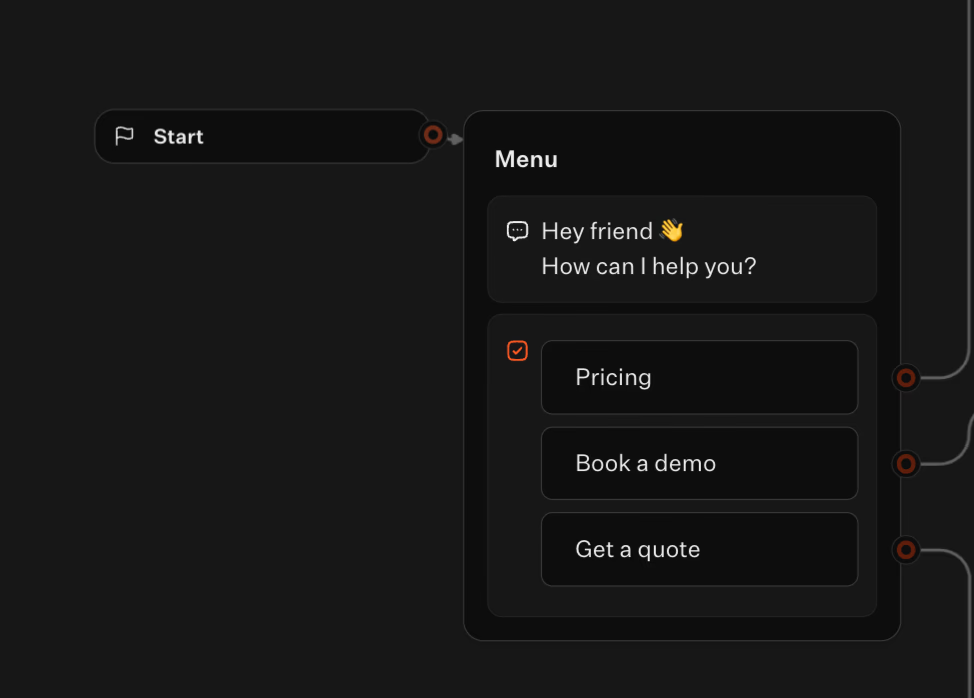
- Use input fields to collect emails, phone numbers, and other custom information with validation.
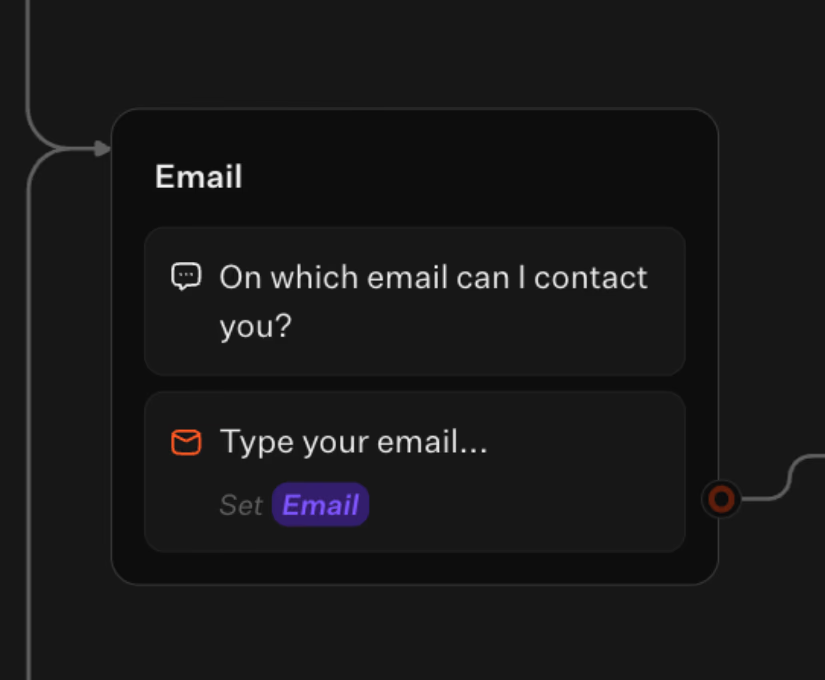
- Build branching logic to qualify users. For example, by asking, “Are you shopping for yourself or your company?” Capture their responses as variables for later use.
Regarding media and format:
- Typebot supports images, MP4 videos, and interactive elements.
- Some formats like GIFs and SVGs may not work on WhatsApp.
- Customize tone and branding so responses match your style.
Designing Conversation Flows That Qualify Leads Automatically
Design flows with clear calls to action and progressive qualification in mind. You can organize them into funnel stages with specific actions:
- Awareness: collect source information and basic demographics, for example, “Company name?”
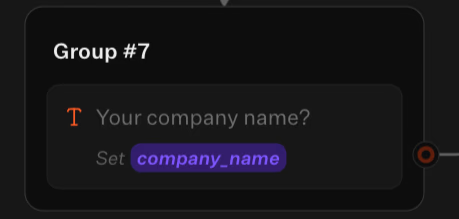
- Interest: highlight product features, ask about pain points, budget, or timeline.

- Consideration: offer personalized options and send demos or resources.
- Conversion: show booking links, payment options, or schedule follow-ups.
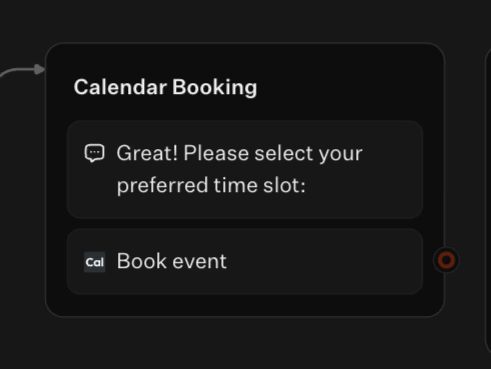
Use branching logic so certain answers, like “B2B pricing,” trigger specific follow-ups. Such as “How many seats?” Set escalation rules that automatically route larger opportunities to sales reps.
Start with a short, friendly prompt. Offer 2 to 4 button choices, then use conditional questions to gather qualifying information.
Integrating Your Chatbot with CRM Systems
A lead is valuable only if it triggers action. Typebot connects with CRMs through webhooks and integrations to send conversation data to tools. These include Salesforce, HubSpot, Google Sheets, Airtable, or helpdesk software.
Integration capabilities include:
- Sending qualified leads directly to CRM or automation platforms using webhooks or integration blocks.
- Using Google Sheets or Airtable for light tracking and reporting.
- Accepting payments through Stripe or similar services during chat.
- Incorporating AI platforms like OpenAI, Anthropic, or Mistral for advanced dialogue, sentiment analysis, or predictive scoring.
Set up notifications via Slack or email for urgent handoffs. Ensure agents receive full chat history when taking over conversations.
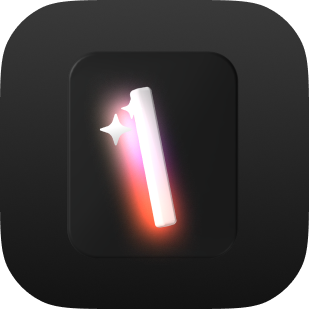
Integrate Typebot with your favorite tools and watch your workflow thrive.
No trial. Generous free plan.
Testing and Deploying Your WhatsApp Chatbot
Connecting Typebot to WhatsApp requires a Meta app and proper configuration on both platforms. The setup takes about 15 minutes and doesn't require coding experience.
First, create a Facebook Business account at https://business.facebook.com if you don't already have one. Next, navigate to https://developers.facebook.com/apps and click "Create App."
Step 1: Select "Other" as your use case.
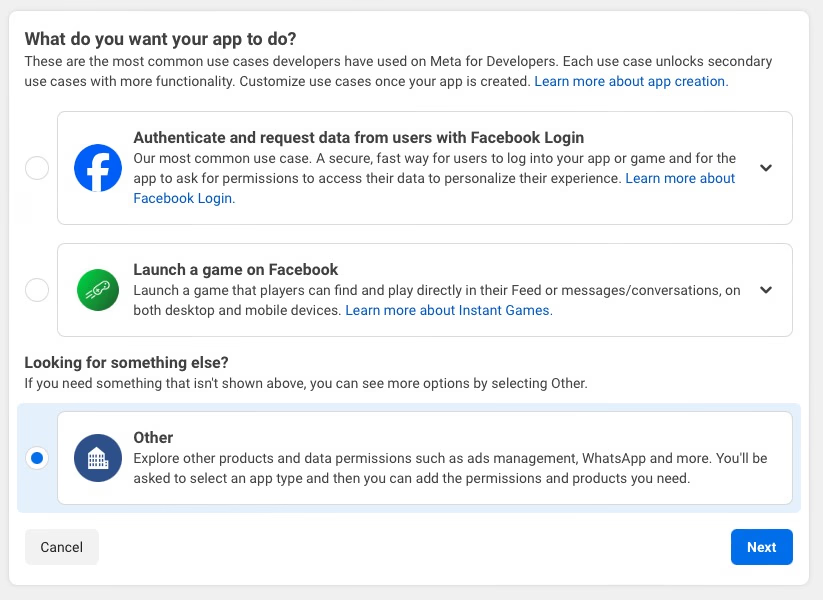
Step 2: Choose "Business" as your app type.
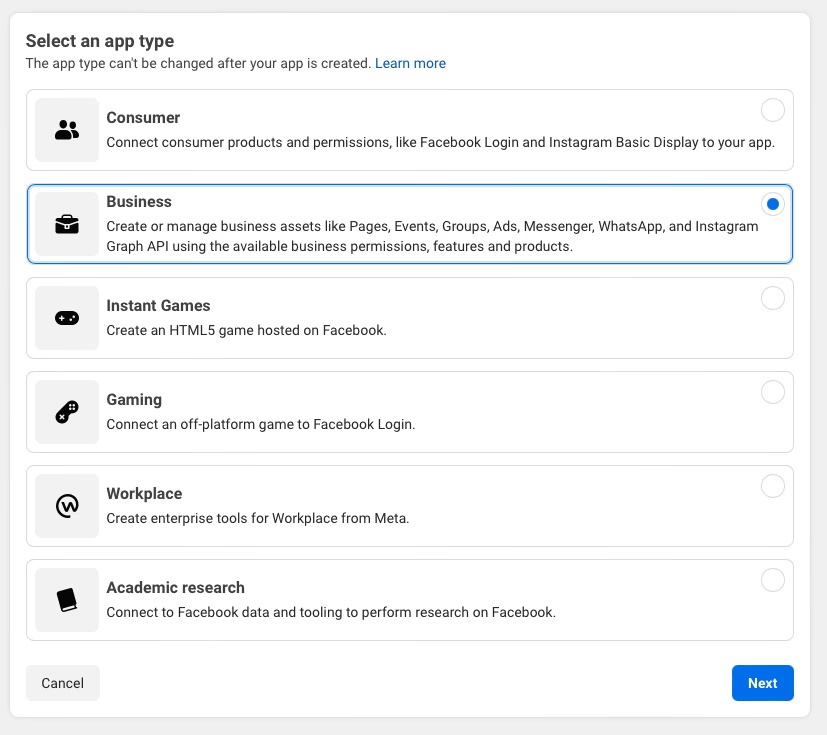
Step 3: Enter your app name and contact email.
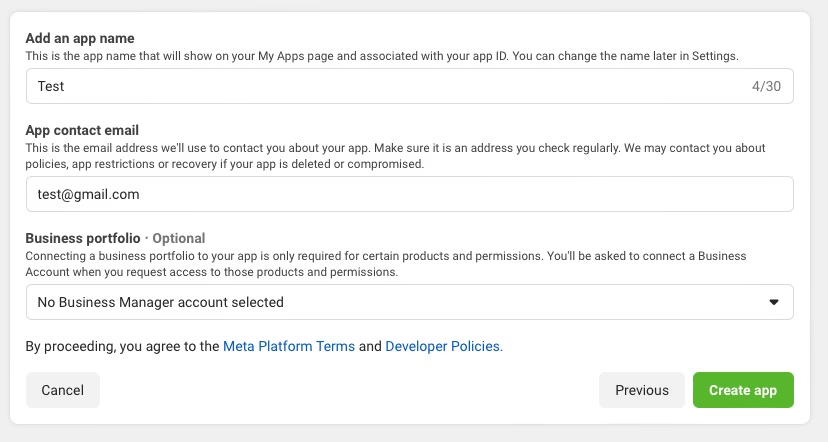
Once your app is created, add the WhatsApp product from the product list.
Your Meta app is now ready for integration.
Connecting Typebot to Your WhatsApp Number
Now link your Typebot chatbot to WhatsApp:
- Go to your System Users page in Meta Business Settings
- Click Add to create a new system user
- Name the user and assign it the Admin role
- Click Add Assets, find your app under the Apps section, and enable Manage App permissions

- Generate an access token and copy it into your Typebot WhatsApp settings
- In the WhatsApp Developer Console, add and verify your phone number
- Copy the Webhook URL and Verify Token from Typebot
- Paste both values into the Webhook fields in your WhatsApp Developer Console
- Click Verify and Save
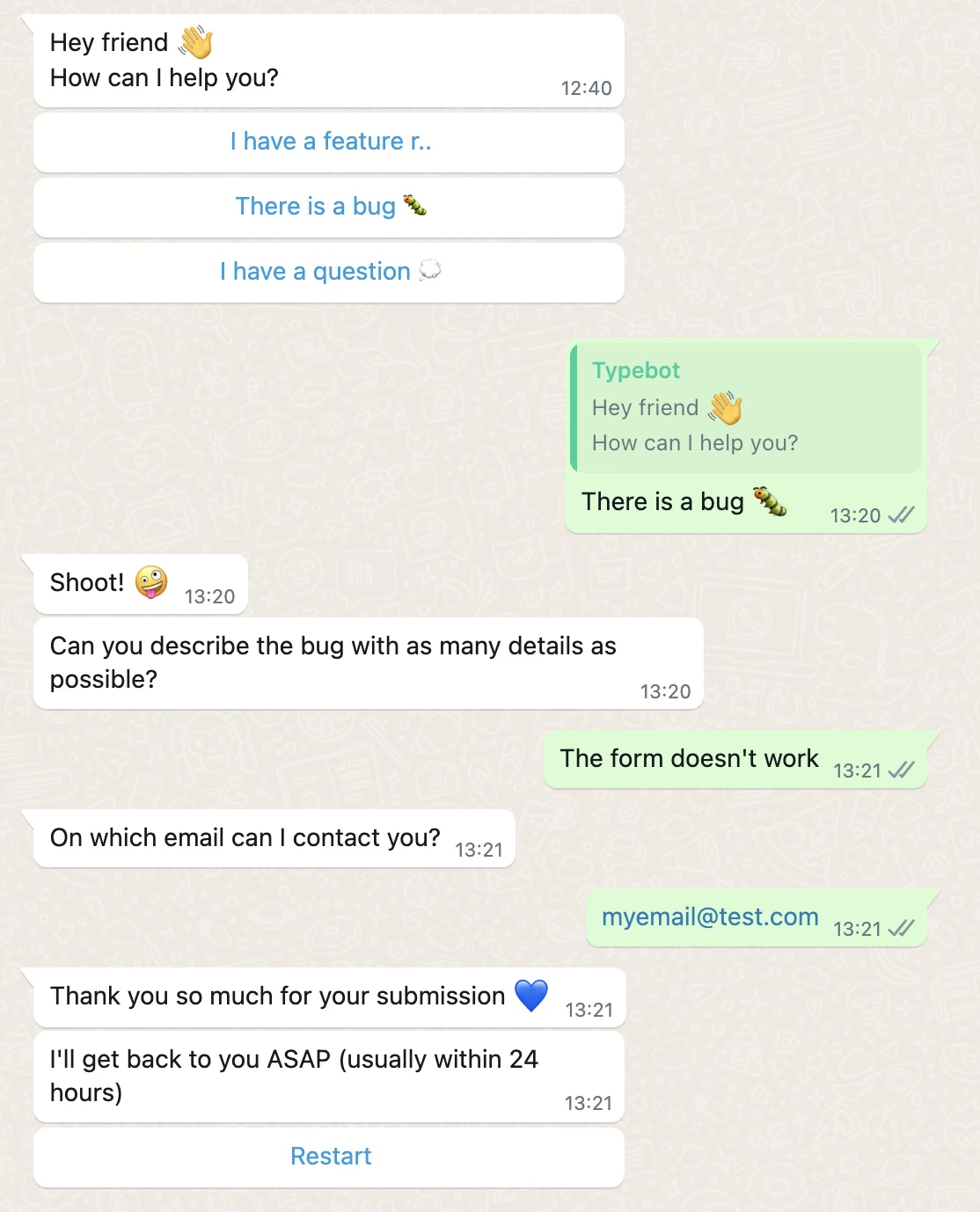
Test your connection by sending a message to your WhatsApp number. Your Typebot flow should trigger automatically.
Publishing Your WhatsApp Chatbot
After testing your flows and confirming everything works correctly, publish your chatbot:
- Navigate to the Share tab in Typebot

- Follow the publishing checklist provided
- Configure any additional integrations with your CRM or analytics tools
- Share your WhatsApp number with customers through your website, ads, or social media
Important: WhatsApp requires businesses to submit their app for review before sending messages to users outside your test group. This process typically takes 1-3 business days.
Once approved, monitor your chatbot's performance through Typebot's analytics dashboard. Track metrics like response rates, completion rates, and drop-off points. Use this data to refine your flows and improve lead qualification over time.
Advanced WhatsApp Chatbot Features with Typebot
Enhance your chatbot with features like:
- Session timeouts and reset logic after inactivity.
- Conditional triggers to start flows based on user input, such as mentioning “Demo” or scanning a QR code.
- Variables for personalized messages and dynamic routing.
- Direct CRM updates via webhooks, payment processing through Stripe, and custom tracking with Google Sheets.
- Automatic capture of WhatsApp user data like name and phone number for instant personalization.
These features allow bots to handle complex qualification and provide smooth transitions to human agents.
Beyond rule-based automation, WhatsApp AI agents powered by large language models represent the next evolution in lead generation.
These intelligent assistants can understand natural language. They adapt responses based on context and handle nuanced conversations that traditional chatbots struggle with.
A WhatsApp AI agent can interpret vague queries like I need something for my team. It asks clarifying questions dynamically, scores lead quality in real-time. It blends automated qualification with human-like dialogue.
By integrating AI platforms like OpenAI or Anthropic through Typebot, you can create agents that learn from each interaction. They continuously improve their ability to identify buying signals and personalize recommendations. All while maintaining the speed and scalability of automation.
Monitoring and Optimizing Your WhatsApp Chatbot
Track key metrics to measure performance and identify friction points:
- Completion rates and where users drop off.
- Button click-through rates and how often fields are completed.
- Time to first response and how frequently chats escalate to humans.
Use dashboards or export data as CSV files to analyze trends. Then improve your bot by adjusting copy, reordering questions, testing different calls to action, and running A/B tests. Regular updates keep your bot improving its conversion rates.
Take Your WhatsApp Lead Generation Live Today
WhatsApp lead generation works because it meets prospects where they already are—in the app they check dozens of times per day. With 98% open rates and response rates up to 60%, no other channel delivers this combination of reach and engagement.
The nine entry points in this guide give you multiple ways to start conversations. The automation tools help you qualify and nurture leads without hiring a support team. And the compliance framework ensures you build trust while scaling sustainably.

Reach your audience where they are. Integrate Typebot with WhatsApp for seamless, personalized communication.
No trial. Generous free plan.